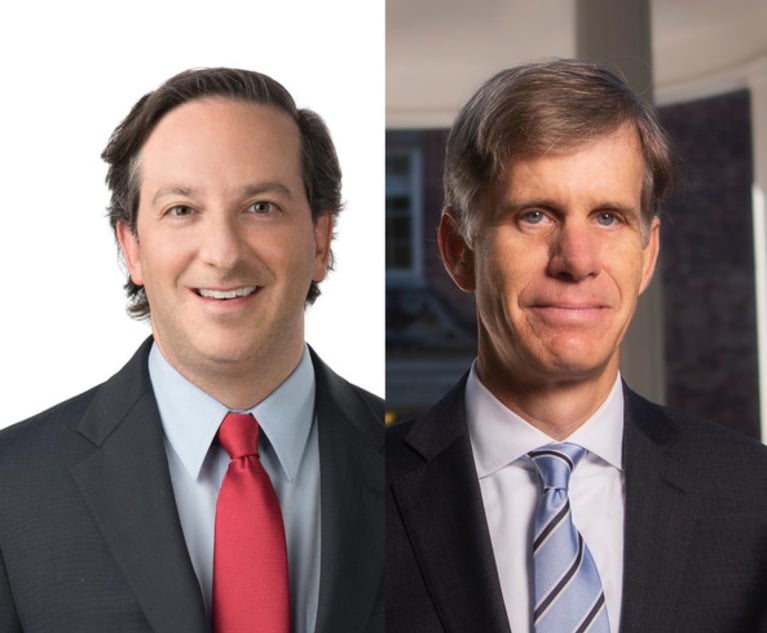Judge Nixes $9.5M MARTA Verdict Over Flawed Jury Charge
Judge Gail Tusan said the court's response to jurors' questions undercut the "crux" of MARTA's defense, and ordered a new trial.
October 02, 2018 at 01:36 PM
6 minute read
 Judge Gail Tusan, Fulton County Superior Court. (Photo: John Disney/ALM)
Judge Gail Tusan, Fulton County Superior Court. (Photo: John Disney/ALM)
(Correction appended below)
A Fulton County judge has tossed a nearly $9.6 million jury verdict against MARTA and ordered a new trial after finding jurors were confused by a thrice-clarified jury charge involving an intoxicated man who fell through a hole in a guardrail at the Civic Center Station and died.
The order crafted by Superior Court Judge Gail Tusan said the final jury charge, which concerned whether MARTA or the deceased man had “superior knowledge” of the hole, undercut the “crux” of MARTA's defense.
Jurors sent out questions three times, indicating they were struggling. After being instructed the last time by Senior Judge Wendy Shoob that they could “weigh the [parties] relative degrees of fault,” the jury awarded more than $11 million, apportioning 10 percent of the fault to the victim and 5 percent to a nonparty defendant.
”Unfortunately, this court must find that there was error in the response to the jury's third question on the issue by injecting the question of fault as a proper basis for the the jury's evaluation of the superior knowledge question,” Tusan wrote.
Tusan was originally assigned the case, but it was tried by Shoob in May because of a scheduling conflict.
MARTA's lead attorney, Thomas “Woody” Sampson II, said his team thought Shoob would be more familiar with the details of the trial and could thus fulfill the role of “13th juror” in assessing their motions for a new trial and judgment notwithstanding the verdict.
But Tusan took up the posttrial motions and, after oral arguments earlier this year, ruled that the issue was one of law and not the details surrounding the death of Carlos Hicks, Sampson said.
“They argued that MARTA knew the hole was there for years, but that wasn't the point,” Sampson said.
“If hundreds of MARTA employees saw it and it was there for five years, and Mr. Hicks only saw it for a minute, that doesn't matter,” Sampson added.
Hicks “had to have seen it, so neither party had superior knowledge,” said Sampson, whose team includes Thomas Kennedy Sampson & Tompkins colleagues Jeffrey Tompkins and Gerond Lawrence.
Hicks' estate and son are represented by Ed Piasta, Christopher Newbern and Michael Walker of Piasta Newbern Walker and Darren Summerville and Max Thelan of The Summerville Firm.
“Obviously, this was not the ruling we were hoping for, but we respect the trial court's efforts,” Newbern said via email.
“The issue—the interplay between the superior knowledge concerns at play in premises cases, and the apportionment statute—is a thorny one,” Newbern said. “That is why we have asked the trial court for a certificate of immediate review, so that the Court of Appeals might take up an immediate opportunity to guide not only any future trial in this action, but other litigants as well.”
The case began in February 2013 when Hicks, 42, was on the station's upper level waiting for a train. A metal guardrail had been removed from a concrete parapet several years earlier as part of a construction project to build a hotel adjacent to the station.
The project was canceled in 2007, but the metal rail was never replaced. Instead, a wooden rail was erected, but it fell off, leaving a 25-inch gap.
The defense portion of the pretrial order said video showed Hicks leaning on the wall adjacent to the hole for several minutes, then turn and step back in an apparent attempt to again lean against the parapet.
Hicks plummeted more than 20 feet to the ground and died. Hicks had a blood alcohol content of 0.311 percent at the time of his death, nearly four times the legal limit for intoxication, the order said.
Hicks' son, Pissaro Wright, and sister and estate administrator Christina Hicks, sued MARTA.
MARTA in turn pointed to the hotel developer, Novare Centennial Park, as the liable party because it had removed the handrail and never replaced it, associating them into the case as nonparty defendants.
Shoob read the jury charges after a two-week trial, including the pattern charge for superior knowledge, along with a nonpattern defense charge that “if a person had equal or superior knowledge of the dangerous hazard or would have had equal or superior knowledge had he exercised ordinary care for his personal safety, he cannot recover.”
The jury asked the meaning of “superior knowledge” during deliberations and were given a near-identical version of the pattern charge. They then asked two more questions concerning the applicability of superior knowledge to each party and whether there were differing standards for negligence and premises liability.
After consulting with the lawyers, Shoob issued a charge including the instruction that jurors could “weigh the relative degrees of fault” and could allocate that fault to any or all of them.”
The charge “was entered over our objections,” Sampson said.
The jury awarded $11,250,000 in damages on May 10, apportioning 10 percent to Hicks and 5 percent to Novare. MARTA's share of the award came to $9,562,500.
Tusan denied MARTA's motion for judgment notwithstanding the verdict on Sept. 27 but granted its motion for a new trial.
The jury was clearly struggling with the superior knowledge and negligence issues, Tusan wrote.
“The jury's confusion, coupled with the fact that the court's fourth and final charge on the issue represented an erroneous statement of legal principles which are most certainly the 'crux' of MARTA's case and thus substantial and harmful as a matter of law, requires the court to grant MARTA's motion for new trial on this sole basis,” Tusan said.
The initial version of this article mistakenly said attorney S. Leighton Moore was among the defense counsel. Moore was not involved in the case, and the story has been updated to reflect that fact.
This content has been archived. It is available through our partners, LexisNexis® and Bloomberg Law.
To view this content, please continue to their sites.
Not a Lexis Subscriber?
Subscribe Now
Not a Bloomberg Law Subscriber?
Subscribe Now
NOT FOR REPRINT
© 2025 ALM Global, LLC, All Rights Reserved. Request academic re-use from www.copyright.com. All other uses, submit a request to [email protected]. For more information visit Asset & Logo Licensing.
You Might Like
View All

On The Move: Ex-Partner Returns to Lead Nelson Mullins Corporate Group, Burr & Forman Hires University GC as COO
5 minute read
Law Firm Sued for Telemarketing Calls to Customers on Do Not Call Registry

Evidence Explained: Prevailing Attorney Outlines Successful Defense in Inmate Death Case
Trending Stories
- 1We the People?
- 2New York-Based Skadden Team Joins White & Case Group in Mexico City for Citigroup Demerger
- 3No Two Wildfires Alike: Lawyers Take Different Legal Strategies in California
- 4Poop-Themed Dog Toy OK as Parody, but Still Tarnished Jack Daniel’s Brand, Court Says
- 5Meet the New President of NY's Association of Trial Court Jurists
Who Got The Work
J. Brugh Lower of Gibbons has entered an appearance for industrial equipment supplier Devco Corporation in a pending trademark infringement lawsuit. The suit, accusing the defendant of selling knock-off Graco products, was filed Dec. 18 in New Jersey District Court by Rivkin Radler on behalf of Graco Inc. and Graco Minnesota. The case, assigned to U.S. District Judge Zahid N. Quraishi, is 3:24-cv-11294, Graco Inc. et al v. Devco Corporation.
Who Got The Work
Rebecca Maller-Stein and Kent A. Yalowitz of Arnold & Porter Kaye Scholer have entered their appearances for Hanaco Venture Capital and its executives, Lior Prosor and David Frankel, in a pending securities lawsuit. The action, filed on Dec. 24 in New York Southern District Court by Zell, Aron & Co. on behalf of Goldeneye Advisors, accuses the defendants of negligently and fraudulently managing the plaintiff's $1 million investment. The case, assigned to U.S. District Judge Vernon S. Broderick, is 1:24-cv-09918, Goldeneye Advisors, LLC v. Hanaco Venture Capital, Ltd. et al.
Who Got The Work
Attorneys from A&O Shearman has stepped in as defense counsel for Toronto-Dominion Bank and other defendants in a pending securities class action. The suit, filed Dec. 11 in New York Southern District Court by Bleichmar Fonti & Auld, accuses the defendants of concealing the bank's 'pervasive' deficiencies in regards to its compliance with the Bank Secrecy Act and the quality of its anti-money laundering controls. The case, assigned to U.S. District Judge Arun Subramanian, is 1:24-cv-09445, Gonzalez v. The Toronto-Dominion Bank et al.
Who Got The Work
Crown Castle International, a Pennsylvania company providing shared communications infrastructure, has turned to Luke D. Wolf of Gordon Rees Scully Mansukhani to fend off a pending breach-of-contract lawsuit. The court action, filed Nov. 25 in Michigan Eastern District Court by Hooper Hathaway PC on behalf of The Town Residences LLC, accuses Crown Castle of failing to transfer approximately $30,000 in utility payments from T-Mobile in breach of a roof-top lease and assignment agreement. The case, assigned to U.S. District Judge Susan K. Declercq, is 2:24-cv-13131, The Town Residences LLC v. T-Mobile US, Inc. et al.
Who Got The Work
Wilfred P. Coronato and Daniel M. Schwartz of McCarter & English have stepped in as defense counsel to Electrolux Home Products Inc. in a pending product liability lawsuit. The court action, filed Nov. 26 in New York Eastern District Court by Poulos Lopiccolo PC and Nagel Rice LLP on behalf of David Stern, alleges that the defendant's refrigerators’ drawers and shelving repeatedly break and fall apart within months after purchase. The case, assigned to U.S. District Judge Joan M. Azrack, is 2:24-cv-08204, Stern v. Electrolux Home Products, Inc.
Featured Firms
Law Offices of Gary Martin Hays & Associates, P.C.
(470) 294-1674
Law Offices of Mark E. Salomone
(857) 444-6468
Smith & Hassler
(713) 739-1250






